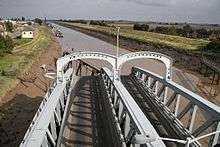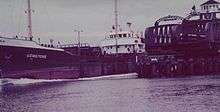Crosskeys Bridge
Crosskeys Bridge is a swing bridge that spans the tidal River Nene in Sutton Bridge, Lincolnshire. When it was built in 1897, it was the third bridge to cross the Nene in Sutton Bridge. The bridge is still in use today carrying the busy A17 between Lincolnshire and Norfolk. It was originally a dual purpose bridge serving the Midland and Great Northern Joint Railway Company on what is now the westbound carriageway and the road was on the eastbound side. The railway line was closed in 1965 and the bridge took on its present-day use as a road bridge. It is a Grade II* listed structure.[1]


History
The first bridge, opened in 1831, was designed by John Rennie the Younger and Thomas Telford as part of the Wash Embankment works. It was of timber and cast iron construction and opened up rather like London's famous Tower Bridge. However it was found to be awkwardly sited and in 1850, its replacement designed by Robert Stephenson was opened.
The position of the second bridge was approximately halfway between the original and the present day bridge. It was a swing bridge and was used only for road traffic until 1864 when the Midland Railway acquired powers to also use it for rail traffic. When the current bridge was constructed it was hoped that the 1850 bridge could be left in position for rail use however the river authorities decided that two bridges so close together constituted a hazard for shipping, and it was removed.
The present Crosskeys Bridge was built in 1897 at a cost of £80,000. Andrew Handyside and Company erected the bridge and Armstrong Whitworth built the engines which supplied the power to swing the bridge and which were installed in the Hydraulic House, a separately listed Grade II* building.[2] The Hydraulic House is now undergoing conversion to a family home but will retain the hydraulics and accumulators, which are housed in a 40-foot (12 m) high tower.
Tolls were charged on the bridge until 1903. The bridge swings several times a week to allow ships and pleasure craft using the River Nene to pass through to the Port of Wisbech.
The bridge was used during the filming of the 2007 adaptation of Philip Pullman's novel, The Golden Compass.
References
- Historic England. "CROSS KEYS BRIDGE (FORMERLY INCLUDING HYDRAULIC ENGINE HOUSE) (1064536)". National Heritage List for England. Retrieved 12 June 2015.
- Historic England. "HYDRAULIC ENGINE HOUSE (1204796)". National Heritage List for England. Retrieved 12 June 2015.
| Wikimedia Commons has media related to Crosskeys Bridge. |